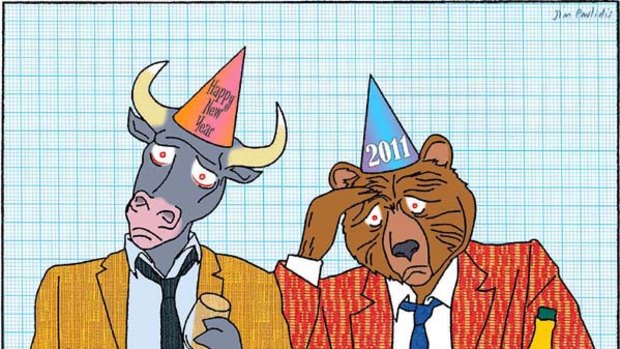By Jessica Irvine
The economic buzzwords you'll need if you want to sound in the know in 2011.
IT'S the season for relaxed beachside banter. But perhaps, like me, you've exhausted all possible chit-chat about how many tonnes of mince pies you consumed at Christmas or how you really think you'll only bother staying up for the 9pm fireworks next year. Perhaps you're ready for the challenge of my Top 10 guide to the economic buzzwords and phrases of 2011, which, when mastered, will enable you to converse freely with friends and colleagues in the months to come.

Illustration: Jim Pavlidis
1. Commodity boom mark IIBefore the financial crisis so rudely interrupted, the Australian economy was riding high on the biggest commodity price boom since the Korean War wool boom. In 2011, the boom is back and even bigger than before. Reserve Bank governor Glenn Stevens has called it ''the largest minerals and energy boom since the late 19th century''. Treasurer Wayne Swan has supplied this somewhat snappier title.
2. Rebalancing of growthAfter two years living on government stimulus support, 2011 is the year the Australian economy must learn to fly on its own. As public spending fades, we must all hope the private sector steps in to take its place. Mining is strong, but with construction and retail spending still quite weak, economic policymakers are holding their breath to see how this delicate rebalancing act plays out.
3. The three-speed economyThe two-speed economy is so last year. Why not dazzle your friends with your fresh take on ''the three-speed economy''? Instead of dividing the economy into states - West Australia and Queensland in the fast lane and New South Wales and Victoria in the slow - the three-speed analogy splits the economy by industries. Outgoing Treasury secretary Ken Henry gets the credit for this. By his reckoning, the fastest group of industries are the mining and mining-related industries, which prosper as export prices rise. The slowest comprise every other trade-exposed sector, such as manufacturing, that suffer as the mining boom pushes up the dollar. In the middle are services sectors that do not export - roughly three-quarters of the economy.
4. Dutch diseaseAn oldie but a goodie, this is likely to be the year we start to worry anew about ''Dutch disease''. Otherwise known as the ''natural resources curse'', this is what happens to an economy when rising export prices push up the value of the local currency, causing the hollowing out of other export and import-competing industries such as manufacturing. The name refers to the Netherlands' experience after the discovery of large natural gas fields led to a decline in manufacturing.
5. The NAIRUIf you really want to win friends and influence people, try casually name-dropping this most obscure economic acronym (and my personal favourite) into conversation. Standing for the ''Non-Accelerating Inflation Rate of Unemployment'', the NAIRU refers to the lowest possible jobless rate before labour shortages start to fuel wages pressure and inflation. Treasury estimates the NAIRU at about 5 per cent. So, with the jobless rate already at 5.2 per cent and Treasury expecting it to fall to 4.75 per cent by the middle of the year, it's time to start planning those NAIRU parties.
6. Supply constrained economyAt this point, it's time to stare into the middle distance, sigh, and wonder what life will be like in our new ''supply constrained economy''. Distinct from ''demand constrained'' - as happens during recessions when demand for goods and service evaporates - ''supply constrained'' is when an economy is running at the limits of its productive capacity. All the workers are at work and machines are operating around the clock. In this environment workers can more easily demand pay rises, businesses must pay more for their inputs and inflation risks abound. Life in a supply constrained economy usually means higher interest rates. Happy new year everyone!
7. Cost of living pressureSo turn your whimsy to anger; get ahead of the game by complaining early and often about ''cost of living pressures''. No mug politician is going to point out that at least you have a job and incomes are rising - not the case in every country - so go for it. In particular, 2011 will likely mark the return of whingeing about petrol prices, as recovery in the global economy rekindles demand for fuel and crude oil.
8. DeleveragingThen, as your Christmas-period credit card statement arrives this month, join the rest of Australia in vowing to ''deleverage'', or pay down some of your debts in anticipation of higher interest rates. The retailers won't thank you for it, but saving is the new black.
9. Budget austerityAnd the same goes for government. In Australia, austerity is warranted. In a supply constrained economy, any spending the government does employs workers and resources that the private sector needs. They must bid more for scarce resources and, as such, it is inflationary. The Gillard government must exercise austerity. More worryingly, austerity is also in vogue in the United States and Europe. With ballooning debts, these governments are looking to slash spending even as their economies are still flirting with recession. Which brings us to the last catch-cry for 2011 …
10. Jobless growthThis is what happens when economic growth is too anaemic to generate enough demand for workers to keep pace with a growing population or to significantly reduce the jobless rate. This is the current situation in the US, where it has been a tough Christmas for the 10 per cent of the American workforce still out of a job.
So, as you grudgingly return to work this month, just think, it could be worse: you could have no job to return to at all.
Jessica Irvine is a Fairfax economics writer.